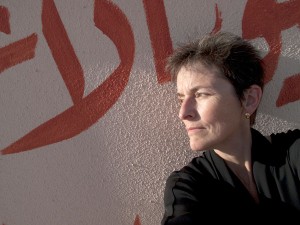When Janice Levy, professor of cinema, photography, and media arts, went to Saudi Arabia last year for a 10-day workshop, she had no idea that the experience would later lead to a 10-month sabbatical.

After being inspired by the short visit, Levy went back to teach students photography at Princess Noura University in Riyadh.
Levy said photography can be a tool for social change and preserving culture while seeing the world in a different way. Staff Writer Candace King spoke with Levy about her experience and the role of photography in bridging the two cultures.
Candace King: Did you run into any cultural barriers in Saudi Arabia?
Janice Levy: The students themselves have grown up in a system where they have had limited access to information. There were things they didn’t know about. Things that we would know from history and factual events, they had not been taught. I was bringing to them information that was brand new to them. There were big gaps in their education, and I had to be very careful how I talked about things because you never want to insult the prophet — you never want to say anything that would offend anybody.
CK: In what way did photography play a role in bridging the two cultures together?
JL: The students really took to photography. They loved it. The students loved taking pictures because there’s this natural inclination that people have to document their lives. However, the idea of taking pictures with your cell phone was very different from the idea of taking pictures with a real camera. There was something about a big camera that felt so much more intrusive and real, if you will, than taking pictures with a cell phone which felt like almost a “throw away” picture. The girls were very secretive about taking pictures. Most of them did not want their faces photographed, but they loved to take pictures.
CK: In an interview, you said that the students “knew very little of their own city and the outside world.” What do you mean by that?
JL: This has a lot to do with the fact that many of them are told that “Riyadh is a dangerous place” and that “men are bad.” The majority of people who do the real labor in Saudi Arabia are immigrant workers from places like India, Sri Lanka, the Philippines — very impoverished countries. This is the work that the Saudis don’t want to do, and so the girls grow up hearing from their parents that these people are dangerous — they’re not nice.
CK: How was this experience different from the others you’ve had?
JL: I’ve taught abroad in a lot of different countries, but Saudi Arabia was very different in a lot of ways. For one, I was working in a situation where women’s freedom was very limited. For instance, Saudi Arabia is a country that practices Sharia law, and the women, when they go out, have to be completely covered, and they are not allowed to go out without being accompanied by a male who is their guardian. I had expectations initially that my students would be able to just walk around the streets and take photographs as you would — like my students here — and they couldn’t. That wasn’t something that was normal for them. I also didn’t realize that the university had restrictions on the time that I could spend with my students outside the classroom. Whereas we can go on field trips here very easily, that was impossible there. You didn’t have the freedom to interact in the way we do with our students here.
CK: Aside from teaching at the university, did you pursue additional work in Saudi Arabia?
JL: Whenever I could, I was out taking pictures. But there was a big program that I started there that I was very proud of, and it was a collaboration between the Princess Noura University students, my class and the Disabled Children’s Association. My Princess Noura University students taught disabled children how to take photographs. I wanted the photography students at Princess Noura to learn about community service and to learn about disability, which is huge in Saudi Arabia, but people sort of just sweep under the rug because they don’t want to confront the problem. I wanted them to learn about humanity and the kids at the Disabled Children’s Association were so great. We would go there every once in a couple of weeks and teach these kids how to use cameras. The pictures the disabled children took were amazing. We got to see what their lives were like through their eyes.







